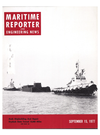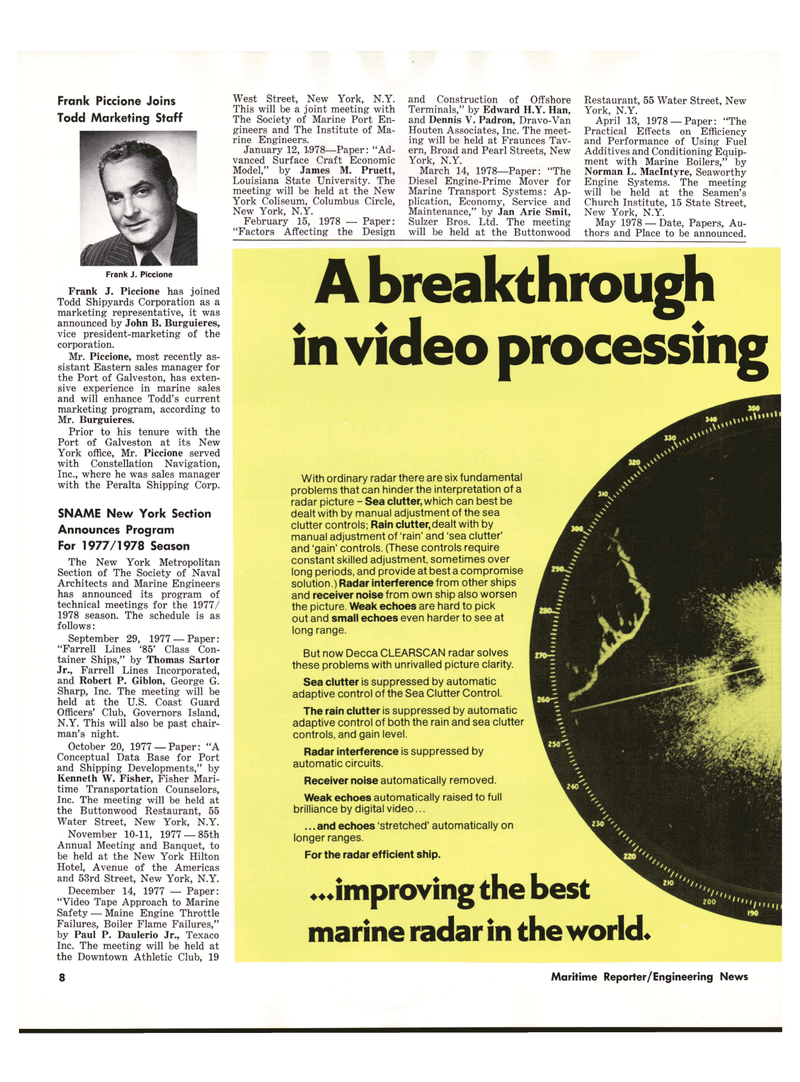
Page 6: of Maritime Reporter Magazine (September 15, 1977)
Read this page in Pdf, Flash or Html5 edition of September 15, 1977 Maritime Reporter Magazine
Frank Piccione Joins
Todd Marketing Staff
Frank J. Piccione
Frank J. Piccione has joined
Todd Shipyards Corporation as a marketing representative, it was announced by John B. Burguieres, vice president-marketing of the corporation.
Mr. Piccione, most recently as- sistant Eastern sales manager for the Port of Galveston, has exten- sive experience in marine sales and will enhance Todd's current marketing program, according to
Mr. Burguieres.
Prior to his tenure with the
Port of Galveston at its New
York office, Mr. Piccione served with Constellation Navigation,
Inc., where he was sales manager with the Peralta Shipping Corp.
SNAME New York Section
Announces Program
For 1977/1978 Season
The New York Metropolitan
Section of The Society of Naval
Architects and Marine Engineers has announced its program of technical meetings for the 1977/ 1978 season. The schedule is as follows:
September 29, 1977 — Paper: "Farrell Lines '85' Class Con- tainer Ships," by Thomas Sartor
Jr., Farrell Lines Incorporated, and Robert P. Giblon, George G.
Sharp, Inc. The meeting will be held at the U.S. Coast Guard
Officers' Club, Governors Island,
N.Y. This will also be past chair- man's night.
October 20, 1977 —Paper: "A
Conceptual Data Base for Port and Shipping Developments," by
Kenneth W. Fisher, Fisher Mari- time Transportation Counselors,
Inc. The meeting will be held at the Buttonwood Restaurant, 55
Water Street, New York, N.Y.
November 10-11, 1977 — 85th
Annual Meeting and Banquet, to be held at the New York Hilton
Hotel, Avenue of the Americas and 53rd Street, New York, N.Y.
December 14, 1977 — Paper: "Video Tape Approach to Marine
Safety — Maine Engine Throttle
Failures, Boiler Flame Failures," by Paul P. Daulerio Jr., Texaco
Inc. The meeting will be held at the Downtown Athletic Club, 19
West Street, New York, N.Y.
This will be a joint meeting with
The Society of Marine Port En- gineers and The Institute of Ma- rine Engineers.
January 12, 1978—Paper: "Ad- vanced Surface Craft Economic
Model," by James M. Pruett,
Louisiana State University. The meeting will be held at the New
York Coliseum, Columbus Circle,
New York, N.Y.
February 15, 1978 — Paper: "Factors Affecting the Design and Construction of Offshore
Terminals," by Edward H.Y. Han, and Dennis V. Padron, Dravo-Van
Houten Associates, Inc. The meet- ing will be held at Fraunces Tav- ern, Broad and Pearl Streets, New
York, N.Y.
March 14, 1978—Paper: "The
Diesel Engine-Prime Mover for
Marine Transport Systems: Ap- plication, Economy, Service and
Maintenance," by Jan Arie Smit,
Sulzer Bros. Ltd. The meeting will be held at the Buttonwood
Restaurant, 55 Water Street, New
York, N.Y.
April 13, 1978 —Paper: "The
Practical Effects on Efficiency and Performance of Using Fuel
Additives and Conditioning Equip- ment with Marine Boilers," by
Norman L. Maclntyre, Seaworthy
Engine Systems. The meeting will be held at the Seamen's
Church Institute, 15 State Street,
New York, N.Y.
May 1978 — Date, Papers, Au- thors and Place to be announced.
A breakthrough in video processing
With ordinary radar there are six fundamental problems that can hinder the interpretation of a radar picture - Sea clutter, which can best be dealt with by manual adjustment of the sea clutter controls; Rain clutter,dealt with by manual adjustment of 'rain' and 'sea clutter' and 'gain' controls. (These controls require constant skilled adjustment, sometimes over long periods, and provide at best a compromise solution.) Radar interference from other ships and receiver noise from own ship also worsen the picture. Weak echoes are hard to pick out and small echoes even harder to see at long range.
But now Decca CLEARSCAN radar solves these problems with unrivalled picture clarity.
Sea clutter is suppressed by automatic adaptive control of the Sea Clutter Control.
The rain clutter is suppressed by automatic adaptive control of both the rain and sea clutter controls, and gain level.
Radar interference is suppressed by automatic circuits.
Receiver noise automatically removed.
Weak echoes automatically raised to full brilliance by digital video... ...and echoes 'stretched' automatically on longer ranges.
For the radar efficient ship. improving the best marine radar in the world* 14 Maritime Reporter/Engineering News

 5
5

 7
7
